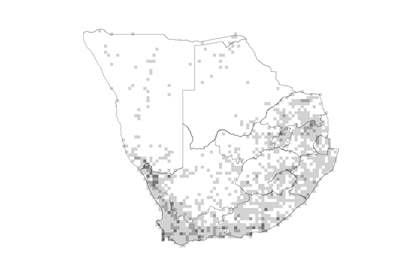 Species distribution and density. Darker squares represent higher density of members of this family. |
Introduction
Crassula family
A diverse family of mostly succulent plants preferring dry, rocky habitats worldwide; almost absent from humid tropics. Some members are highly sought after by succulent plant collectors.
Distribution
Found throughout the world, but especially in warm, dry areas with centres of diversity in Mexico and South Africa. In southern Africa the highest diversity is found in mountainous areas in the more arid parts of the region.
Number of genera in the world
ca. 34
Number of species in the world
ca. 1 410
Number of genera in the Flora of southern Africa region
6
Number of species in the Flora of southern Africa region
430
Well-known southern African genera
Cotyledon, Crassula, Tylecodon
Growth forms
Herbs and small shrubs, usually succulent.
Habitats
Characteristic of exposed, rocky areas with a few species adapted to frost-hardy and even aquatic habitats.
Flagship species
Cotyledon orbiculata (pig's ear; plakkie [A]; serilele [SS]; ipewula [X, Z]) is a widespread species found throughout southern Africa. It is a small shrub with woody branches and thick, succulent leaves. The leaves usually have a reddish margin and are covered with a waxy layer. The flowers are tubular, orange or red and borne on a long stalk. The leaves and leaf juice is used to treat corns and warts, earache, boils and inflammation. This plant also causes krimpsiekte (shrinking disease) in livestock.
Significance of the family
Members of the family are widely cultivated as ornamentals in rock gardens or as collector's items (Cotyledon, Crassula, Kalanchoe, Tylecodon). Some species are used medicinally or as love charms but certain genera are toxic (Cotyledon, Tylecodon) causing krimpsiekte, a major cause of livestock losses, especially in arid areas. Larvae of the tailed black-eye butterfly feed on crassulas. An abundance of some Cotyledon species indicates mismanaged veld.
Diagnostic characters
Leaves opposite or spirally arranged, rarely whorled, often in basal rosettes , succulent with no stipules. Flowers mostly regular with 4 or 5 (sometimes more) free or basally connate sepals and 4 or 5 (sometimes more) petals, free or connate to form a corolla tube . Flowers small but borne in showy corymbs or panicles . Ovary superior �, with 3 to 5 separate carpels (sometimes slightly joined at the base). A nectar gland � is present at the base of each carpel. Fruit usually a head of free follicles enclosed by dry petals. (Photo : ALV; : GN).
Did you know?
Members of this family are easily propagated from cuttings, leaves or adventitious buds.